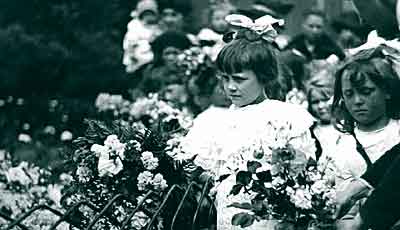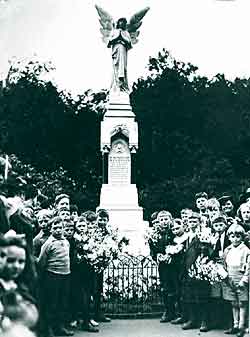 |
|
 |
  |
 |
|
The story behind an unusual war memorial, drawn from contemporary newspaper accounts
|
|
The memorial today
|
|
WHAT HAPPENED
Death From The Sky
The morning of Wednesday June 13 1917 was hot, and the sky was hazy. Nevertheless, onlookers in London's East End were able to see 'a dozen or so big aeroplanes scintillating like so many huge silver dragonflies'. These three-seater bombers were carrying shrapnel bombs; that morning they killed 104 people.
Sixteen of the dead were 5- and 6-year olds, in their classroom at Upper North Street School, Poplar; two older children also died. 'The sun had been shining, and then it seemed to go out in a roar of thunder.'
|
|
Content
1. WHAT HAPPENED
Death From The Sky
Outburst of Feeling
The King's Message
Away from the Din
In Memoriam
2. HOW PEOPLE RESPONDED
What people said
References
Further reading
|
|
An Extraordinary Outburst of Feeling
This was the first ever daylight air-raid. It was also one of the first civilian tragedies of 'total' war; and the deaths of the children in particular caught the public's emotions. The funeral, on June 20, was a major public event.
'Signs of sorrow and sympathy were visible throughout the whole of the East End. On every hand blinds were drawn, shutters fixed, and flags had been lowered to half-mast. Preceded by the boys' band of the Poplar Training School, the coffins were borne through vast and silent crowds of people.' The last coffin held unidentified 'broken fragments of little bodies'.
|
 |
|
|
The wreaths, well over 600 of them, excited comment and admiration. They came from local people - individuals, schools, community organisations and institutions - and also from 'the children of Norfolk', New Zealand troops, the 'Kodak Girl' revue company, the Naval Pay Officers Department, Poplar Ambulance Corps, and the Fathers of the Custom House. A local photographer sent a wreath in the shape of a school slate; there were simple bunches of wild flowers; and a galaxy of wreath designs - harps, crosses, broken columns, cushions, anchors, even a shrine.
The funeral service at Poplar Parish Church was conducted by the Bishop of London. Among the mourners were many children, including those who 'had themselves been extricated from the medley of powdered brick, wood and human flesh and blood in their school building after the bomb explosion'.
'When the congregation rose to sing the hymn "There's a Friend for Little Children", few were able to control their voices. One poor girl-mother fainted, but was revived by her husband, whose tender care as he held her in his arms in full view of the congregation showed the depth of his grief - else no Englishman would so far lose his self-consciousness.'
The King's Message
The King had visited the East End immediately after the raid. Now the Bishop of London read to the congregation a 'simple and sincere' personal message from King George, who, with Queen Mary, was thinking of the children's parents and 'their saddened homes, especially today when the bodies of their little ones are laid to rest'.
'The early ending,' the King's message went on, 'of young innocent lives, at all times pathetic, is made so more than ever in these tragic and cruel circumstances. Their Majesties pray that the mourners may be blessed with God's help and comfort in their sorrow.'
Away from the Din
The Mayor of Poplar and Will Crooks, the local MP, headed the raising of a 'convalescents' fund, to send bereaved mothers and traumatised children away for a fortnight's recuperation.
|
|
|
|
At the beginning of July the first parties - 14 mothers, some with babies, and 70 children from Upper North Street School - set out for 'the beautiful up-river resort of Maidenhead. Women and children appeared delighted at the prospect of a couple of weeks amidst the sylvan charms of Berkshire, away from the din and nerve-trying memories of Poplar. A small party, including the Mayoress, also went to Maidenhead 'to see the mothers and children safely installed in their holiday cottages, and that every comfort conducive to health was provided'.
In Memoriam
A fund was also set up to raise a memorial. It brought in £1,455, 19 shillings and 11 pence: a very large sum for the time. People felt that 'the memorial should also be of such a character as to benefit the living' - so part of the fund was used to endow one bed in the local children's hospital and another in a Hampshire home for crippled children.
On June 23, 1919, with appropriate ceremony, a stone memorial was unveiled to the children of whom the Mayor of Poplar had said: 'These boys and girls as truly suffered for their country as any men who have perished in the trenches, on the high seas or in the air'. The memorial was set up in Poplar Recreation Ground. It is built of marble and granite, in a Victorian Gothic design surmounted by an angel with spread wings, and inscribed with the names of the children who died. To this day it arouses emotion in people who stop to look at it.
|
 |
|
|
|
|
|
|
|
|
|
|
|
 |